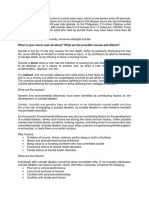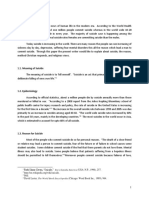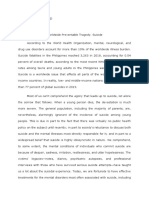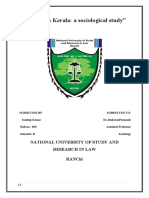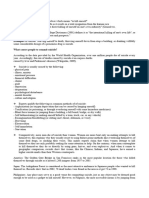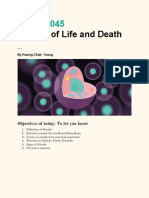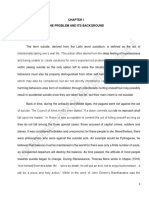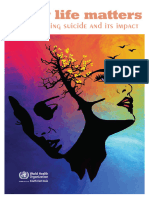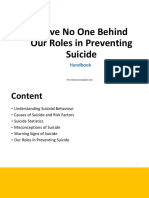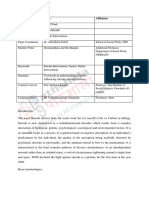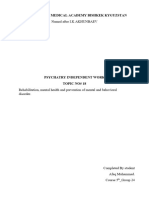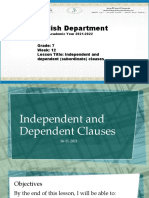INTRODUCTION
Life is essentially a given to the human person. This gift constitute the primordial right of
every human person, thus one talks about his rights when the right to life is firstly secured. Given
its primacy, everyone is called to the preservation of life. However, people make attempts
against life; the most irresponsible of it all is when individual persons make attempts on their
own life which they are primary custodians of. The personal attempt on one’s own life is suicide.
Suicide can be defined as intentional self-inflicted death with evidence that the person intended
to die.1 Suicide is lethal violence. Suicide constitutes a serious public and mental health problem.
Thus the right to life does not suppose that one can decide to take his life. While everyone has
the right to life, no one have the right to suicide. The value placed on human life precedes the
individual himself. The most valuable thing we have is our life. Though it is vulnerable and
fragile, unique and limited by its possibilities; nonetheless, it is the only one and ultimate.
Humans, being self defensive, have a natural will to live. Therefore anyone one with a desire
against one’s own life is not a usual or ordinary case. However on this paper concerns itself with
suicide and the value of human life.
WHAT IS SUICIDE?
Suicide is the act of man against himself. It is death caused by injuring oneself with the
intention to die. However, a suicide attempt is when someone harms themselves with the intent
to end their life, but they do not die as a result of their actions. 2 Suicide is associated with several
risk and protective factors; it is connected to other forms of injury and violence, and causes
serious health and economic consequences. For example, suicide risk is higher among people
who have experienced violence, including child abuse, bullying, or sexual violence. Other
characteristics associated with suicide include a history of suicide attempts and lack of problem-
solving skills “Suicide is used by Durkheim as a means of demonstrating the key impact of social
factors on our personal lives and even our most intimate motives. However suicide is a complex
phenomenon, but it is preventable and must be prevented especially because of the value of life.
Even so, every 40 seconds a person dies by suicide somewhere in the world and many more
attempt suicide. Suicides occur in all regions of the world and throughout the lifespan. Notably,
1
Jacobs DG, Baldessarini RJ, Conwell Y, Horton L et al. Suicide behavior practice guidelines for assessment and
treatment of patients with suicidal behavior, American Journal of Psychiatry 2003, 160:3, 60.
2
“Violence prevention”, www.cdc.gov/violenceprevention/pdf/suicide-factsheet.pdf (accessed 22 December 2020)
�among young people 15-29 years of age, suicide is the second leading cause of death globally. 3
Suicidal behavior is a leading cause of death and disability worldwide.
The WHO in her report remarks that “Suicide impacts on the most vulnerable of the
world’s populations and is highly prevalent in already marginalized and discriminated groups of
society. It is not just a serious public health problem in developed countries; in fact, most
suicides occur in low and middle-income countries where resources and services, if they do exist,
are often scarce and limited for early identification, treatment and support of people in need.
These striking facts and the lack of implemented timely interventions make suicide a global
public health problem that needs to be tackled imperatively. 4 Social, psychological, cultural and
other factors can interact to lead a person to suicidal behaviour, but the stigma attached to mental
disorders and suicide means that many people feel unable to seek help. Despite the evidence that
many deaths are preventable, suicide is too often a low priority for governments and policy-
makers. Restricting access to the means of suicide is a key element of suicide prevention efforts.
However, means restriction policies (such as limiting access to pesticides and firearms or putting
barriers on bridges) require an understanding of the method preferences of different groups in
society and depend on cooperation and collaboration between multiple sectors.5
CAUSES OF SUICIDE OR SUICIDE ATTEMPTS
This question itself presupposes another. Should the present state of suicide among
civilized peoples be considered as normal or abnormal? Suicidal behaviour among young adults
is a significant social and psychological problem; however, little research explores its meaning
from the suicidal individual’s perspective. A qualitative study identified common themes and
personal meanings that characterized the experiences of young adults who had made one suicide
attempt between ages 20 to 24. Six major themes identified were (a) family experiences, (b)
adolescent interactions, (c) emotional experiences, (d) self-destructive behaviours, (e)
depression, and (f) perception of control. Suicidal attempts were viewed from the perspective of
a continuous process that encompassed the individual world view and experiences rather than as
3
World Health Organization, Preventing Suicide: A Global Imperative, WHO Library Cataloguing-in-Publication Data,
Geneva 2014, 3.
4
Ibid,
5
Ibid, 7.
�isolated events.6 Understanding suicidal behaviour from a singular perspective is likely
inadequate because psychological, interpersonal, and existential components contribute
significantly to the interpretation and meaning given by an individual to their life experience;
interpretations are unique and multifaceted. Understanding suicide and suicidal behaviour as
multi-determined provides a broader spectrum from which to develop effective intervention
strategies and therapeutic interventions. Suicidal behaviour is hypothesized to be a compilation
of a painful situation, a constricted cognitive state, overpowering emotions, and disturbing
relationships, and is conceptualized as adjustive but not adaptive. The distressed individual
perceives suicide to be the last available option. Death provides a solution to end the conscious
awareness of pain.7
THE VALUE OF HUMAN LIFE AND SOLUTION TO SUICIDE
Life is a complex journey viewed through different lenses. However, each lens
acknowledges the primordial value placed on life. The claim that human life is valuable, even
sacred, has its foundation in God’s creation of humankind: “So God created man in his own
image, in the image of God he created him” (Genesis 1:27). This truth imparts extraordinary
value to every life, independent of gender, race, socioeconomic position, age, or health status.
Those who hold to biblical creation must attach great worth to human life and will stand in its
defense. Our creation in God’s image is at the heart of the biblical injunction against murder:
“Whoever sheds the blood of man, by man shall his blood be shed; for in the image of God has
God made man” (Genesis 9:6). By placing His mark upon humankind, God clearly established
His own authority over human life and holds accountable those who would usurp it. 8 Life is a
sacred gift, and suicide is a desperate act by one who views life as intolerable. Such self-
destruction is never condoned, but faith communities increasingly support, rather than condemn,
the person who contemplates or engages in suicidal behavior. They acknowledge that mental and
substance use disorders, along with myriad life stressors, contribute significantly to the risk of
suicide. And they reach out compassionately to the person who attempts suicide and to families
and friends who have been touched by a suicide or suicide attempt. This increasingly charitable
understanding finds agreement between the historic precepts of faith and a contemporary
6
Robin D . Everall, The Meaning of Suicide Attempts by Young Adults, Canadian Journal of Counselling / Revue
canadienne de counseling /2000, Vol . 34:2, 1.
7
Ibid, 2.
8
General Presbytery in session, Sanctity of Human Life, Suicide and Euthanasia, August 9-11, PDF 2010, 2.
�understanding of illness and health. It renders no longer appropriate the practice of harshly
judging those who have attempted or died by suicide.9 Although there has been substantial
progress in the development of efficacious treatments for a variety of mental health concerns,
such has not been the case for suicidal behavior. Indeed, while intervention efforts for suicidal
behavior have increased considerably in recent decades, no corresponding decrease has been
observed in the prevalence of these phenomena.
ANTHROPOLOGICAL ISSUES AT STAKE
Suicide, by definition, is fatal. Suicide also affects the health of others and the
community. When people die by suicide, their family and friends often experience shock, anger,
guilt, and depression. The economic toll of suicide on society is immense as well. People who
attempt suicide and survive may experience serious injuries, such as broken bones or organ
failure. These injuries can have long-term effects on their health. People who survive suicide
attempts can also have depression and other mental health problems. In addition to the number of
people who are injured or die, many other people are impacted by knowing someone who dies or
by personally experiencing suicidal thoughts. Additionally, being a survivor or someone with
lived experience increases one’s risk of suicide. 10 There is a large societal consensus about the
inviolability of life. This is founded in the Western philosophical and religious tradition;
specifically the thinking of Aristotle and Thomas Aquinas In this tradition there are three ethical
arguments against suicide: it is an offense of man against him or herself, against society and
against God. In the first place, suicide is an offense against one’s own life because people have a
natural tendency toward self-preservation.11 People naturally want to live and strive to preserve
their lives.
ETHICAL EVALUATION OF SUICIDE
Is there an unconditional obligation to live, how far does the duty reach to safeguard life,
and how does one deal with the tension of suicide? Self-preservation of life belongs to natural
9
Suicide Prevention Resource Center. (2009). The role of faith communities in preventing suicide: A report of an
Interfaith Suicide Prevention Dialogue. Newton, MA: Education Development Center, Inc.,
http://www.sprc.org/library/faith_dialogue.pdf (accessed 22 December 2020)
10
Chapman AL, Dixon-Gordon KL. (2007) Emotional antecedents and consequences of deliberate self-harm and
suicide attempts. Suicide & Life Threatening Behavior; 37(5): 543-552.
11
Aquinas, Thomas. n.d. Summa Theologica. IIa IIae, q. 64, a. 5. Ed. Available online: http://dhspriory.org/thomas/
summa (accessed on 21 December 2020).
�law. The inviolability of life, however, remains a generally acknowledged and fundamental
value. Preservation of life, therefore, is an ethical good, while suicide is an evil. Suicide is
fundamentally an expression of a person’s existential quest for meaning. Existential refers to
people’s existence or life. People face life in a certain way and their aim is to find and experience
meaning in life.12 When the meaning of life is lost, life itself can become an unbearable and
hopeless suffering. Such suffering demoralizes people and makes them feel desperate. To get rid
of their agony, they sometimes see no other way of escape than by dying by suicide.
Suicide contradicts the natural law of self preservation, and violates the divine injunction
to love oneself.13 It is a moral violation of the law of justice. John Paul II states that suicide
“involves the rejection of the love of self and the renunciation of the obligation of justice and
charity towards one’s neighbor, towards the community to which one belongs and towards the
society as a whole”.14
WHAT DOES THE CHURCH SAY ABOUT SUICIDE AND HUMAN LIFE?
A summary of the church’s teaching on suicide is that we should be mindful of our lives;
the preservation of our lives, body and soul is an obligation we all have. We are called to
preserve and nourish both our physical and spiritual life. Suicide violates a genuine love for
oneself and one’s neighbors– family, friends, neighbors, and even acquaintances. Other people
need us and depend upon us in ways we may not even know. The Catechism asserts, “Everyone
is responsible for his life before God who has given it to him. It is God who remains the
sovereign Master of life. We are obliged to accept life gratefully and preserve it for his honor
and the salvation of our souls. We are stewards, not owners, of the life God has entrusted to us.
It is not ours to dispose of” (CCC 2280). However, it is important to note that suicide is
distinguished from the sacrifice of one’s life for God or another, as in the cases of martyrdom, or
of offering one’s life or risking it to save another person.15
12
Van Knippenberg, Tjieu. (2002). Towards Religious Identity: An Exercise in Spiritual Guidance, Assen, Van Gorcum,
pp. 95–116.
13
CCC 2281 and 2325
14
John Paul II. Vatican. Evangelium Vitae. 25 March 1995. 19 March 2013.
http://www.vatican.va/holy_father/john_paul_ii/encyclicals/documents/hf_jp-ii_enc_25031995_evangelium-
vitae_en.html, 66.
15
What is the Church’s teaching regarding suicide, https://catholicstraightanswers.com/what-is-the-churchs-
teaching-regarding-suicide/ (accessed 27 December, 2020)
�CONCLUSION
Suicide violates both natural and divine law; an inordinate and immoral solution to
suffering. It is a big humanitarian problem that requires the cooperation of all to defeat. The
government needs to step up in the area of policy provision and implementation to address the
causative factors of suicide. Quality education should be provided, the economy should be
boosted and poverty eradication schemes should be set up. Most importantly awareness should
be created about the moral ills of suicide; the sanctity and inviolability of human life should be
re-emphasized. Additionally, counseling centers should be made available for people going
through turbulent times in order to better help them in the management of depression and mental
challenges.
In terms of policy implications, there are some obstacles to creating suicide prevention
programs: (a) a lack of financial resources, (b) a lack of time, and (c) a lack of training
opportunities. The role of the clergy is the missing link in the prevention of suicide, especially
intergenerational suicide, and raises a red flag for mental health professionals, such as
psychiatrists, psychologists, nurses, and social workers. Although collaboration between clergy
and mental health professionals is essential for suicide prevention, many workers are
overlooking the role of clergy in suicide prevention.16
16
https://journals.sagepub.com/doi/pdf/10.1177/2158244013486992
�BIBLIOGRAPHY
Pantaleon Iroegbu – Anthony Echekwube (Ed), Kpim of Morality Ethics; Genereal,
Special & Professional, Heinemann Educational Books Plc, Ibadan, 2005.
The Catechism of the Catholic church, Society of St Paul, Ibadan 2015.
John Paul II. Vatican. Evangelium Vitae. 25 March 1995. 19 March 2013.
The Journal of Inculturation Theology, Vol. 16 No.2, Faculty of Theology Catholic
Institute of West Africa, 2019.
World Health Organization, Preventing Suicide: A Global Imperative, WHO Library
Cataloguing-in-Publication Data, Geneva 2014.
Jacobs DG, Baldessarini RJ, Conwell Y, Horton L et al. Suicide behavior practice
guidelines for assessment and treatment of patients with suicidal behavior, American
Journal of Psychiatry 2003



